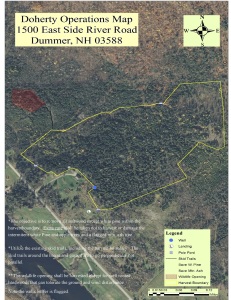The 6 to 8 inches of snow we got yesterday and last night was actually too light and fluffy for snowmen but it may make our grouse hunting pretty tough unless we get a good thaw. Although that’s not in the forecast. When I was clearing off the roofs of the kennels I let the three puppies — Dottie, Molly, and Spot — out for a romp in the snow. They were a little hesitant at first and then did their usual chasing of each other around the yard and in the woods behind the kennel. Won’t be out until the weekend, but with snow on the ground I’ll be hunting areas that have some pretty good fir and spruce thickets where the grouse can seek cover during the day and still find bare ground under the bigger trees as a lot of snow is still up in the softwood trees.
What will end the season for us is if the conditions for the dogs become dangerous. Snow is not a big problem unless it’s really deep. The problems arise when there’s a crust that can rip up feet and ankles and/or a lot of ice underneath which won’t be a problem for a while because everything melted Sunday and Monday to the point that the little snow cover we had was totally gone.
One aspect of our habitat here in Northern New England and throughout the eastern range of the ruffed grouse, is the need for early secessional forest. To that end, we have a big cut planned for this winter and it should start next week. As you can see from the map the central portion of the property (about 30 acres) has grown up into fairly mature spruce and fir. The plan is to remove all that softwood and leave behind all the hardwoods as seed sources. This property was cut fairly heavily 20+ years ago and has always been good grouse and woodcock habitat. However, there have been fewer and fewer woodcock as the woods have matured. We’ve reached the point where last summer I don’t think I flushed a woodcock on the property. This cut should provide better habitat for both grouse and woodcock as well as help pay for the new kennel were building in the spring. The area shaded in red is an additional patch cut that should provide another area for regeneration. The large patch cut we during winter 2011 has not regenerated as quickly as I had hoped partly due to the fact that we cut everything and are only just starting to get new growth around the edges. It is interesting to note that the section of the training course that comes around the south edge of the cut has become one of our most consistent spots to find grouse. There’s apple trees, alders, high bush cranberry and other viburnum along this edge. Once they start cutting I’ll post some pictures of the new habitat we’re creating.



home cover renovations….maybe a discovery channel reality show in the making ?
Hopefully there won’t be enough drama for a reality show!